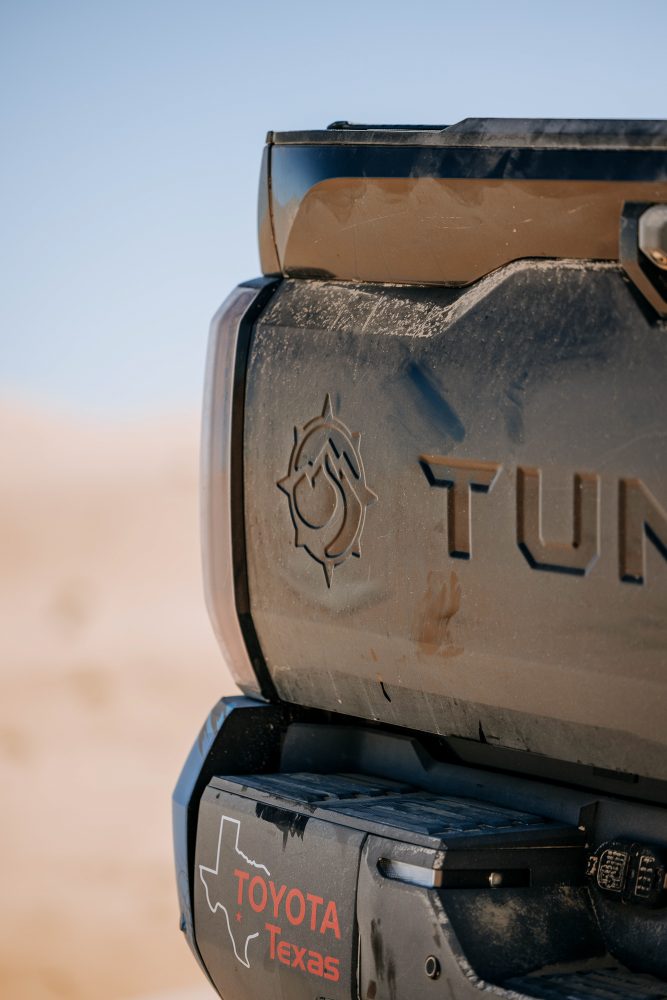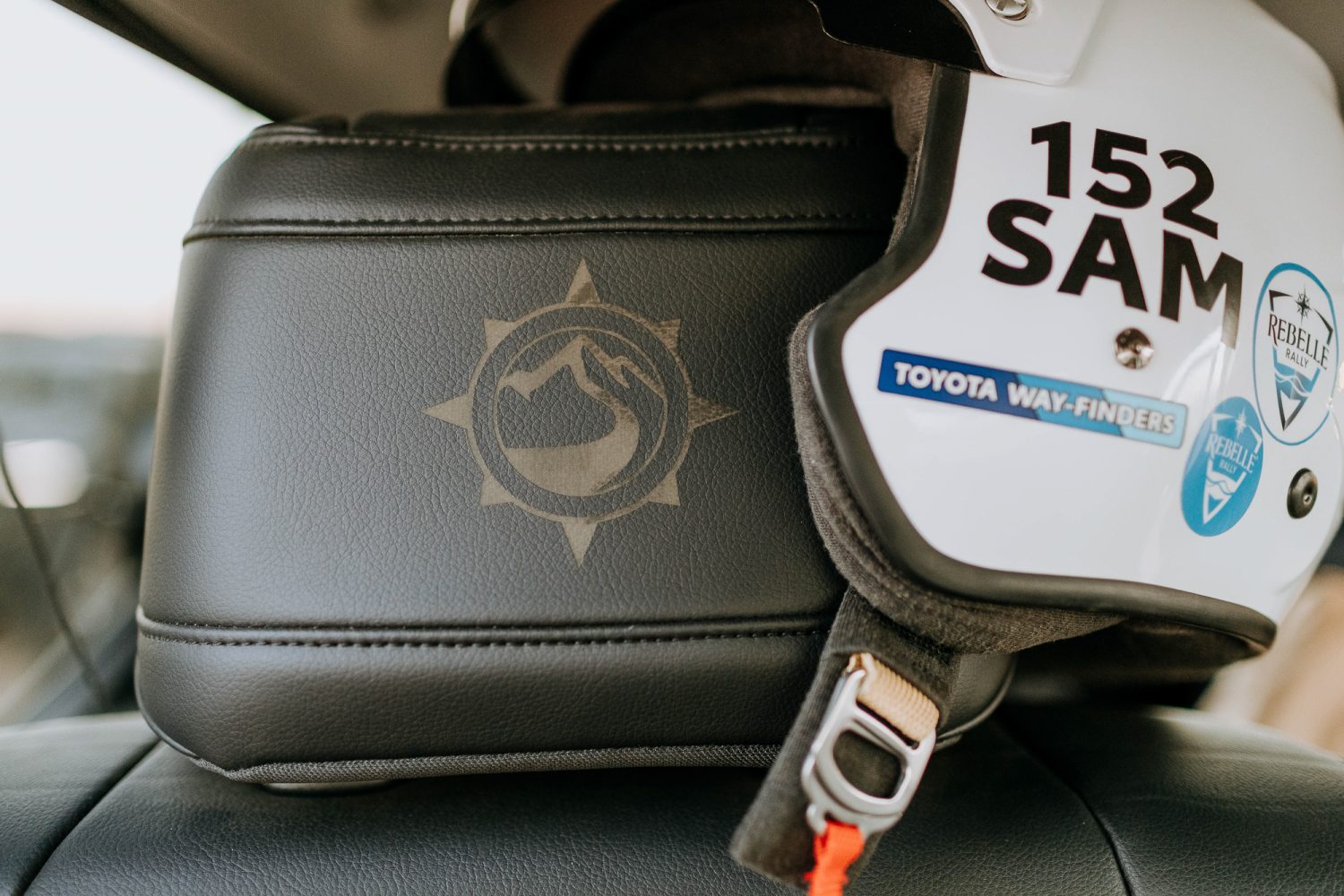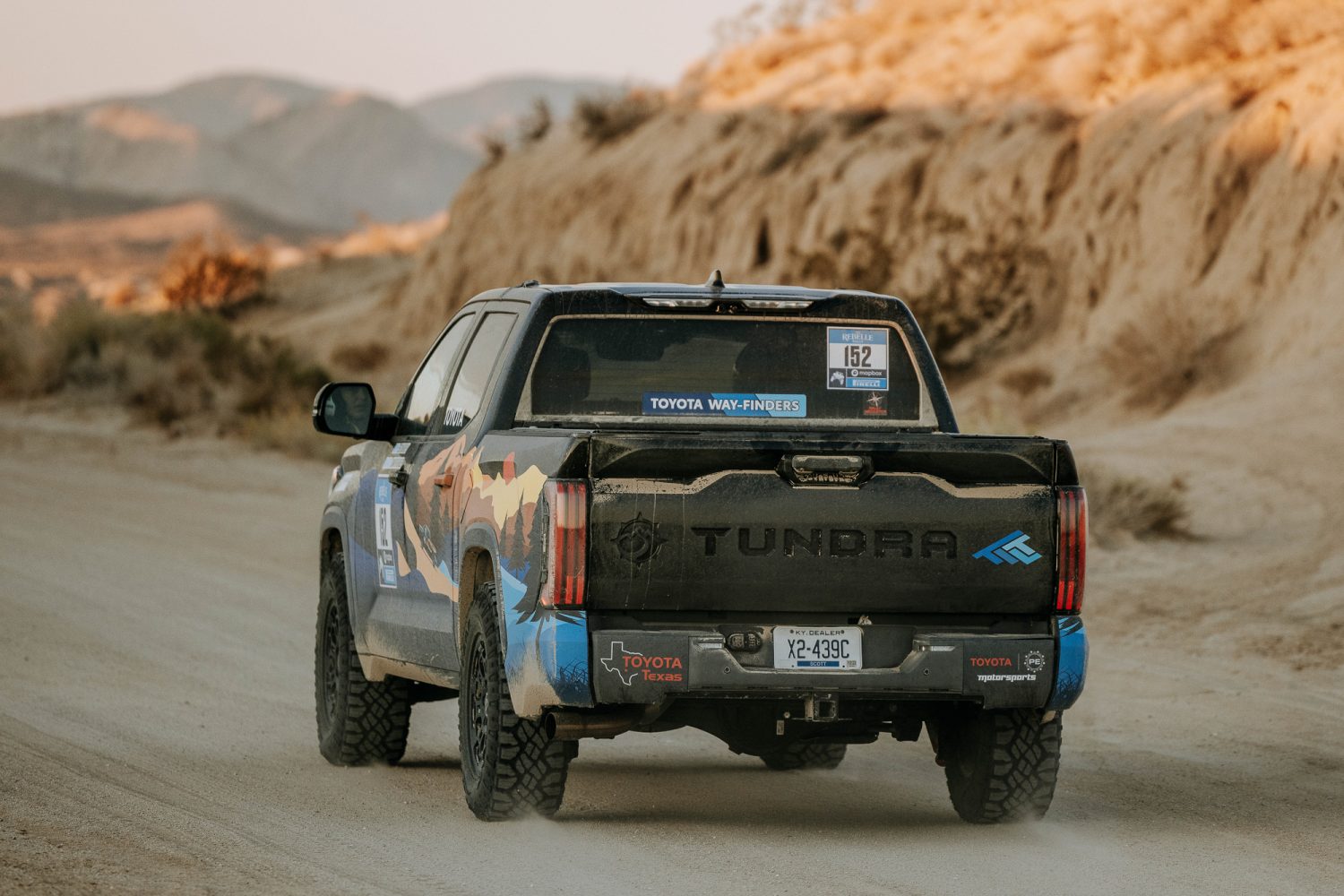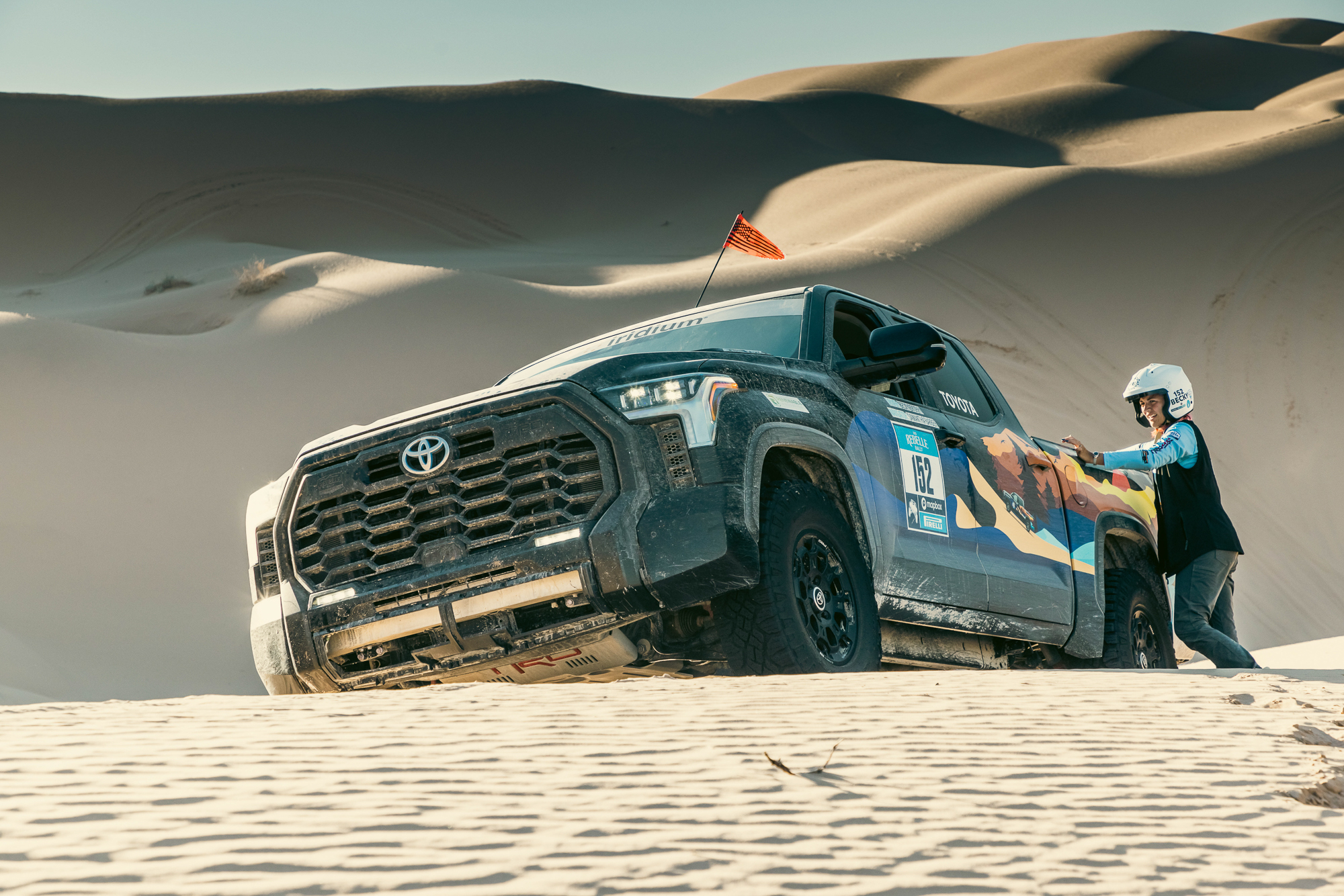Photo by Tim Sutton
Since its inception in 2015, the Rebelle Rally has seen fairly solid support from various original equipment manufacturers. From Jeep to Lexus, Rivian, and even Rolls-Royce, the event is touted as a proving ground for off-pavement testing, ideas, and concepts—but there’s one name that, until 2021, had been curiously absent: Toyota.
Then, along with a shifting marketing narrative around women, trucks, and motorsports, came Toyota engineers Samantha Barber and Becky Brophy. Becky was the first female driver for the Toyota Production Engineering (PE) Motorsports team and Sam is co-chair for Women Influencing and Impacting Toyota, an internal business partnering group. The two pitched competing in the 2021 rally to Toyota executives and succeeded, championing the expansion of Toyota’s PE Motorsports division team to off-road. Winning the Rookies of the Year award in 2021 and clinching third place in the 4×4 division at this year’s rally, they’ve earned the respect of their competitors and, no doubt, their peers and colleagues at Toyota.
But what really makes Brophy and Barber light up is promoting women in engineering, manufacturing, and motorsports and ensuring Toyota is an integral part of the process well into the future. It’s looking good: Toyota will send four teams to next year’s rally. I sat down with Becky and Sam, who provided an interesting glimpse into the production and management side of Toyota, their previous motorsports experience, and what the general public might not know about the 2022 Tundra.

Photo: Richard Giordano
Tell me about each of your roles at Toyota.
Brophy: I’ve been here since 2014, since my first co-op. Most of that time has been in the assembly shop in a group that works on future model development. My role is helping design for manufacturability, working with our designers and manufacturing plants, and putting those two together to understand our current capabilities, future capabilities, and the new models coming down the pipeline. We’re asking, ‘How do we actually build this?’ or considering which features we make to the design so that we can build it.
Barber: My first nine years were engineering-focused. I did new model product management, so where Becky was in the assembly shop, I coordinated and did project management across all shops, including press, weld, paint, assembly, and plastics. For new models, I moved into a very technical role where we focused on quality. I then moved into a digital engineering role where we worked on new technologies, implementing them in a way that made our engineers’ work easier. But over the last year, I’ve covered various tasks in a strategic planning group. We’re looking at where production engineering and the work we do will be five to seven years out, what type of talent we need, what skills we need, what new technologies we need.
What drew you both to the engineering field?
Barber: My engineering journey was a little different. I grew up on a farm in the middle of nowhere. I originally applied to college for dental hygienistry. But a physics teacher of mine said, ‘You should probably consider engineering.’ I thought, I don’t know what that is! After some investigation, I switched from dental hygiengistry to mechanical engineering, but Purdue University had a motorsports program, and in my second year, they offered a dual degree program. After five years, you come out with both motorsports and mechanical engineering. I got into aerodynamics, wind tunnel testing, and chassis and suspension design. When we designed something, we had to go down to the fabrication lab and build it so you could see how bad your design really was. Then I interned for the navy testing weapons, IndyCar doing tech inspection, chassis design for a top fuel dragster team, and then with Cummins for fuel systems. I talked to Toyota at a career fair, and that’s how I got hired out of college.
Brophy: I was good at math and science in school. My dad and older brother are engineers, and it seemed like a good job. Toyota was where I got involved in the motorsports team, which was one reason I wanted to get hired full time. It’s such a cool opportunity outside of my core job that would be hard to find anywhere else.

Photo: Richard Giordano
Did you have a motorsports background?
Brophy: I had very little to no motorsports knowledge before joining the team at Toyota. I learned so much, latched on to it, and found a huge passion. I had no off-roading experience until not long before we did the Rebelle. I bought an old 4Runner at the end of 2019 as a winter beater car, and I had some friends that did some off-roading. We just took it out stock and had a blast. I couldn’t believe how capable it was.
Your rookie year at the Rebelle Rally was in 2021. Why did you decide to compete?
Barber: In February 2020, a co-worker and friend sent me an article [about the Rebelle Rally], and he was like, ‘Have you heard of this?’ I dug in to see what it was. Once I learned about it, I wanted to pitch it to our executives. Toyota is a massive company with many divisions or ‘pillars.’ Production Engineering is within the Manufacturing pillar. We have a motorsports team that primarily does endurance racing, like 24 Hours of Le Mans and One Lap of America. I pitched [the Rebelle] to the executives in motorsports. Becky was a driver in the motorsports team, and I knew from others on the team that Becky had done well at those events. Not knowing her, I sent her a link and said, ‘Do you want to do this?’ Once she said yes (within 10 seconds), we put the slides together and took it to motorsports with the intent of pulling more women into motorsports and getting our PE Motorsports team into off-road because they had always been to on-track events.


Why is it important to introduce more women to the motorsports sector of Toyota?
Barber: I’m passionate about supporting women in a lot of ways. Because I have motorsports and mechanical engineering degrees, women and engineering are very high drivers for me. I’m also co-chair for our internal Women Influencing and Impacting Toyota (WIIT). It was another way to find ways to support those women.
Brophy: I had been involved with our motorsports team in the past. The team started in 2007. I joined in 2015 and was on crew for a couple of years before driving in 2017, and I was the first female driver for the team. That was an honor, but I also wanted to help the visibility of women in motorsports. It can be intimidating to see only men on the team, so I wanted to open that door for women because it was so much fun. I learned a lot, and I wanted everybody to have that same opportunity.
What made you choose the Rebelle Rally over another motorsports event?
Barber: I did the Baja [1000], which was grueling. But the big pieces of the Rebelle were the push for accuracy and strategy, the community, the women, and channeling to support our initiatives internally. It was in perfect alignment.

Photo: Richard Giordano
Have you seen the internal strategy of women in motorsports at Toyota change over time?
Barber: Internally to PE Motorsports, yes. We’ve got women that want to learn what things are, but they’ll even say, “I don’t want to go down there if there are a bunch of men down there,” or they don’t feel comfortable asking what the names of the tools are. Becky has hosted trainings where we invite women in our department to come and learn navigation. We print off big maps and talk about compasses and plotting points.
The engagement is growing, but it also reaches outside our organization. We had one PE team and one Research and Development (R&D) team compete during the first year [2021], and this year, we had two PE teams and one R&D team. We already have two PE and R&D teams registered for next year’s rally. Other sectors of Toyota also want to use this for leadership development. In sponsoring the Live Show, ‘women in Toyota trucks’ was a big piece of the messaging they wanted to get across this year.
You selected and trained Caroline Koenig and Libby Perego for Toyota’s rookie team at the 2022 Rebelle Rally. How did this change your competition experience?
Barber: Last year, I could see the Rebelle community was a cool thing to be a part of, but I felt like I was trying to get into it. This year, I was a part of it and was able to pull in new women. That was a change for me, being the new person and being welcomed and able to welcome others. I enjoyed that change in dynamic for the second year.
Brophy: Not only were we trying to do well, but we were training this other team, rooting for them every step of the way, and always wondering how their rally was going.
Barber: That felt different because we would come in, and I was like, They’re not in yet. Where are they at? What kind of day are they having? It was something else on my mind that I hadn’t anticipated. I hadn’t thought about how I would worry about them whenever they were out on course.
This year, you competed in a hybrid 2022 Tundra Limited TRD Off-Road. How did the vehicle perform?
Brophy: We had plenty of space for our gear, which made it easy to keep things organized. I had multi-terrain select, which comes with the TRD Off-Road package, which allows you to select the terrain you are driving on, and it will adjust shift points or traction control to suit the terrain. I could select dirt mode, downhill, downhill assist control, or crawl control, and we had a panoramic view monitor (PVM) with cameras all around the vehicle. The cameras recognize what you’ll be driving over as you’re driving. I could easily see my tire placement, so that was a tool I used a lot.

Photo: Richard Giordano
What vehicle modifications did you make?
Barber: Both this year and last year, we wanted to keep modifications pretty light—one, to support Emily [Miller]’s message that the vehicle in your driveway is more capable than you think, and two, to show it’s true with our Toyota as well. We did some fun customizations in our Tilt Lab, which is like a prototyping or innovation lab similar to a maker’s space. The team members at the lab etched the Rebelle competitor logo in the grille. Becky and I took apart the whole front end of the Tundra, and they etched that, they etched our headrest, and stamped our tailgate. A new tech and innovation team within our stamping department has been looking at customizing those big sheet metal parts. They designed the compass and mountainscape stamp for us and did the one-off tailgate to showcase what they could do for that truck. That’s a new way for manufacturing to have that connection with the customer through customization. There wasn’t a fuel tank skid plate for the new Tundra, so our Tilt Lab plus Becky fabricated an aluminum fuel tank skid plate and a steel transfer case skid plate.
Brophy: I learned how to weld while making the skid plate and learned how to powder coat as well.
Barber: Other than that, we went a little bigger on the tires and put in an external on the odometer. And the wrap—oh my goodness. We have a graphic designer in-house, and we send him inspiration, from coffee cups to this picture I saw at the Northwest Overland Rally, and he came up with the wrap. Then we discussed colors, and the Tilt Lab printed and installed it; every part of the wrap was done in-house. We tried new things this year, like laminating the wrap in matte rather than gloss, which changed how it looked in all the photos. It’s just another way to learn about what we can do and what looks good in those scenarios.



Becky, you worked on the development of the 2022 Tundra before its release. What part of the production were you involved with specifically? Was there anything you would change now?
Brophy: I started working on the 2022 Tundra in 2019, and at that time, I was focusing on the instrument panel, so your steering wheel, radio, glovebox—the whole front of the car was my responsibility. Honestly, I don’t think there was anything about the truck I would have changed. I loved it. I put so much time and effort into that project and then got to use it for the competition; I really felt a sense of pride.
What’s an interesting fact about the Tundra that the general population might not be aware of?
Brophy: The general public probably doesn’t know that there are quite a few Easter eggs. There are little graphics that bring it back to where it was designed in Michigan and an outline of the state of Texas. They’re hidden, but if you look closely, you’ll find them.



Photo: Tim Sutton
It’s fun to see the interaction of the motorsports, overland, and OEM communities come together at events like the Rebelle Rally. What has this experience taught you in your personal and professional lives?
Barber: There are so many facets that we’re able to engage with because of the Rebelle, like leadership and personal development, but also the connections that Becky and I have formed across our company with other companies. We’re working more closely with our spare parts and accessories division. We’re talking to TRD and our marketing department in ways that production engineering hasn’t ever engaged with before. There’s also that external connection because of the women we meet and the things they do, that web of connection and networking that’s happening.
Brophy: I think what makes us want to keep coming back to the Rebelle is that it’s such a unique competition because your competitors can be your best friends. They lift us up every single day, even if we’re right next to them on the leaderboard. I’ve never been part of any competition that feels that way. You want your competitors to be their best because that helps you be your best.
Barber: Many of us are competing for promotions at Toyota, so you can apply the same thinking we experienced at the Rebelle. If you can give it your best, and [your co-workers] give it their best, everyone will be better.

Photo: Regine Trias
Our No Compromise Clause: We carefully screen all contributors to ensure they are independent and impartial. We never have and never will accept advertorial, and we do not allow advertising to influence our product or destination reviews.
Read more: Cool Vehicles of the 2022 Rebelle Rally


